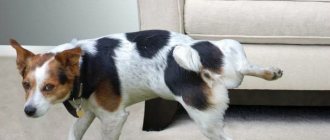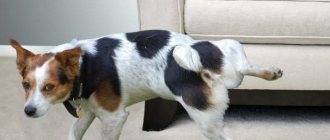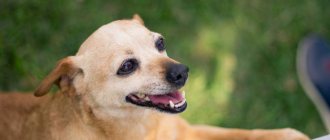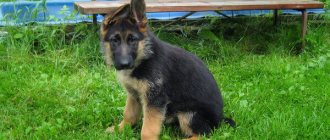Regardless of age, breed and size, the dog must be socialized. A well-mannered pet should not demonstrate hostility towards people and pets without reason - its aggressive reaction can cause harm to both the person against whom it is directed and him.
The dog attacks other dogs, what should I do?
Aggression - where does it come from?
In many cases, the animal's aggression lies on the side of the person who misinterpreted its behavior. The owner's most difficult task is to find the cause of the aggression. Therefore, you should look at everything more carefully: spend more time with your four-legged friend, change the environment often and even provoke certain situations and record the moment when your pet begins to get nervous.
Disease
What are you talking about, we were friends!
A typical picture: a calm, balanced dog suddenly begins to attack its own kind. The owner is shocked, this has never happened, the pet has always treated his own kind favorably. An analysis of the situation begins, the owner tenses up and remembers: the pet began to attack other dogs after he got sick.
Yes, a sick dog is quite capable of showing aggression. This is explained by an attempt to protect themselves, because illness is a reason to be attacked or killed by their own relatives. For example, stray dogs that gather in packs do not stand on ceremony with sick “household members”; they are destroyed.
Reasons why your Pomeranian barks
How talkative a dog is depends on a number of factors - breed, heredity, size. Pomeranians are small dogs, and they (unlike large ones) constantly bark loudly and loudly.
The dog needs frequent communication with its owner. He barks incessantly, asking his owner for as much attention as possible.
Another reason is the loneliness that a pet faces when it is locked in an apartment all day. The Spitz communicates its boredom and desire to do something with a loud bark.
The third reason is the special character of the breed. They need affection, love, understanding, so German Spitz barks ask to be stroked, scratched and caressed.
Despite their miniature size, dogs have a guard instinct, so they use their voice to report approaching danger.
Another reason for loud barking is the pleasure of playing. If a dog stops when ordered and stops barking, this is normal. More often than not, the Pomeranian does not calm down right away and you need to show some character to keep him quiet.
What to do if your pet attacks dogs on the street?
A dog’s aggression towards its relatives is usually explained by a low level of socialization or negative experiences that make the pet afraid of other four-legged animals.
Some pets behave more confidently if they are in their own territory or know that they are in the owner's field of view. Excessive aggression in generally calm dogs can be observed if the pet guards the territory entrusted to it, the owner, his things or his own bowl.
Regardless of the type of aggression shown, try to avoid punishing, humiliating, or intimidating your pet as much as possible. Naturally, if a dog shows aggression towards you, you (once and for all) must give a tough rebuff.
Does a Pomeranian bark a lot and often?
Dogs barking is their way of communicating with humans and other animals on a verbal level. Behind the familiar sound is information that pets try to convey to humans. It is for this reason that domestic animals bark much more often than wild animals.
Dogs make sounds of different ranges and timbres. A roar, a squeal, a howl escapes from the mouth. Any intonation is accompanied by movement of the ears and tail. By carefully observing your pets, it is easy to guess what they want.
The Pomeranian's bark can be rough, shrill and vary in timbre. After listening, the owner understands what happened to him:
- Frightened - the tail is tucked, and the barking turns into a random squeal.
- The dog is cold or bored - a quiet howl.
- Aggression - barks rudely and abruptly.
- Danger - short loud sounds, gradually turning into a growl.
- The desire to play is joyful barking, squealing and yapping, similar to that of a puppy.
The Pomeranian Spitz is very active and vocal, reacts to any sound, even from the next apartment. He sleeps lightly, the baby jumps up and barks at any rustle.
Mental problems
Showdown
And this happens in our time. Even among purebred dogs purchased in mono-kennels from champion parents. Unfortunately, mental problems are especially common in long-haired “show class” German shepherds. At the sight of a fellow dog, the shepherd begins to “yell” at the top of his lungs, tries to rush at the other dog, his withers standing on end.
Attempts to distract and switch do not work. The dog continues the tantrum with an attempted attack until the potential enemy is behind or disappears from sight. Not only “German show dogs” are guilty of this behavior; other large, medium and small breeds do the same.
Final commands and crowd behavior training
Once all the basic commands have been mastered, you can begin to learn more complex tricks.
Jumping over obstacles
You should start learning with not very high obstacles. Take the treat in your hand and lift it over the barrier. As soon as the puppy jumps over the obstacle, he needs to be praised and encouraged.
Walking in crowded places
The Jack Russell Terrier should only be walked on a leash. It is better to take your first walks in uncrowded places, far from busy roads. To socialize your pet, you can introduce it to other dogs. It is better to avoid contact with mongrels.
If your Jack Russell Terrier barks or lunges at other people, you need to yank him on the leash and say “No!”
Riding on public transport
To ride on public transport, your Jack Russell Terrier must be muzzled. You should enter the salon by saying “Nearby!” The terrier should be as close to the owner's feet as possible. Additionally, you can fix it by pulling the leash.
You should also exit the vehicle with the command “Near!”
Lack of obedience
I'm about to bite!
Please do not confuse education and obedience. Obedience is a section of dog training that involves knowledge and execution of primary commands, to put it very roughly. Such commands include “to me”, “next to me”, “sit, lie down, stand”, as well as a ban on certain actions.
The problem is that on the site with a canine handler, the pet is able to carry out commands, including prohibition, just perfectly. But on a walk, at the sight of another dog, the pet’s withers stand on end, and he goes to kill the enemy. The owner tries to prohibit the unwanted action, but the dog does not hear.
This indicates the owner's lack of authority. The owner simply failed to create contact with the dog, motivate it and teach it obedience.
Radical ways of education
You can resort to more radical methods of education. Use shocker collars, “strokers,” and ultrasonic devices that will help you form the right attitude towards your relatives, but only after prior consultation with a dog handler and veterinarian. Stronger stimuli will help to quickly instill in animals the correct behavioral skills and reflexes.
If the cause of aggression is stress, severe fear, or emotional overexcitation, you can give the dog sedatives. Consult your veterinarian regarding the choice of sedatives. Create the most comfortable environment possible, surround your pet with attention, affection and care.
To teach your beloved dog good manners and instill an adequate relationship with other animals, before choosing an educational method, determine the root cause of such behavior. Consider the age, individual, breed characteristics, temperament and type of nervous system of your pet. Always strive to achieve your goals and objectives, but never force your dog to do anything he cannot do.
Fights in dogs living together
Possible fights among dogs living under the same roof, in the same house. What are the reasons and how to solve this problem if several dogs live in one house.
Intraspecific aggression. Hereditary factor.
Where does it come from? Its roots are in the genes of the dog, as a pack predatory but domesticated animal. These are remnants of survival instincts in the wild. This is a struggle between individuals for a hierarchical place in the pack - “who is more important.” This is a struggle for a piece of food, for a female in heat and the opportunity to reproduce. There is also the protection of puppies from other relatives, the protection of members of their pack and its leader from enemies. Finally, this is the protection of rights to territory, an analogue of hunting grounds. And other types of intraspecific aggression. You can come across different types of it while walking with your pet. With different combinations. But there is only one most undesirable outcome – dog fights.
Acquired factors of aggression.
In addition to heredity, there are other reasons for this that have already been acquired.
- Improper upbringing and training of a dog. Or artificially instilling in her aggressive character traits (fighting breeds).
- Incorrect socialization during puppyhood. This is when the puppy was not given the opportunity to communicate with other dogs, his relatives did not teach him their canine language. Or vice versa - as a child, the puppy was exposed to the stress of attacks by aggressive dogs, without receiving protection from the owner. And as a result, his aggressive attitude towards his brothers took hold.
- Inadequate psyche of a dog with inappropriate reactions to other dogs. This happens with mental illnesses in dogs, with training methods that are clearly traumatic to the psyche. Fights in dogs involving such individuals are the most common occurrence.
- The behavior of the owners. Dog communication, even aggressive contact, does not always result in a real fight. It should be understood that for this there must be certain prerequisites. And sometimes we create them ourselves. Then we walk with a bitch in heat in public walking areas. Then we come up to meet all the dogs in a row, on someone else’s territory, far from our own yard. Yes, even on a stricter and a tight leash. Instead of unfastening the leash and, when the situation is tense, the owners have the opportunity to “run away”. This is an effective method! An owner running away from his dog deprives him of both the rear behind him and aggression. Pushing the dog to compromise and peacefully resolve the problem.
But in this part we’ll talk about fights between dogs that live in the same apartment.
Now about the actual inadequate dogs.
A lot of them. The reasons for an inadequate response to another dog in a normal standard situation were indicated above. I repeat: this is incorrect upbringing and socialization, or this is the dog’s unhealthy psyche. After all, an adequate dog in a normal situation first of all shows friendliness towards its fellow dog. Demonstrates poses of respect (not submission, this is completely different), both herself and in response. Yes, there are situations when the interests of dominance, issues of territory control, or sexual issues are affected. But, as a rule, in normal, adequate animals it doesn’t come to the point of dogs fighting! Someone gives in, demonstrating respectful behavior, and if necessary, then showing submission. And that is all! The conflict is over and everything falls into place.
But dogs, like people, can be abnormal and inadequate (poorly educated, unable to communicate correctly, or mentally ill). How can you see such dogs?
It’s very simple: their aggression DOESN’T match the situation and the specific situation. Which, it seems, should not have led to any aggression, and in no way contributed to this.
That's why. If a dog attacks without any warning signs, this is an anomaly. Or a dog is unable to see and distinguish the gestures of another dog - it is also not normal. A dog that attacked a puppy is inadequate! A dog that continues to finish off a dog that demonstrates gestures of concession and submission is an abnormal predator and is clearly abnormal in socio-psychological terms. Just like all such dogs that show aggression in response to gestures of respectful respect and friendliness. These are the dogs that, at the slightest of such observed manifestations, are immediately disqualified from exhibitions for life. They are strictly not allowed for breeding. And such dogs in their wild version are caught and euthanized. Or they shoot back. And it is right.
Fights in dogs living together in the same house (apartment).
A common problem when there are several dogs, especially of the same sex. The roots of such intraspecific aggression are usually in hierarchical disputes. Sexual issues may be mixed in with them, especially during the period of estrus in bitches. Uncertainty in one’s hierarchical position and issues of jealousy can also influence. Fight for food, toys, attention of the owner. Or some moments that provoke dog fights between the owner and his family members. But the basis is always hierarchical structures. At the same time, if one of the dogs shows signs of an inadequate response, this may already be enough. To escalate conflicts into dog fights.
Age factors also play a role. A grown young dog reaches its social maturation at different ages - from 1 year to 3. At the same time, it no longer feels like a puppy and feels the need to increase its hierarchical status. The fights that have occurred do not stop subsequent such attempts in the future. Conflicts can be extinguished for some time, but the risk of their recurrence is high. A little thing is enough. Moreover, during fights, opponents learn, become faster, and more dangerous. The skills of aggression and defense are honed to perfection during a dog fight.
Thus, young dogs of approximately equal size and age will argue over their hierarchical status. No less rare scenarios of conflicts between an adult dog and a grown puppy. And these are not necessarily the puppy’s attempts to improve his status. Even mild changes in the latter's behavior can cause a reaction in an adult dog.
The conflicts themselves may not lead to a fight at first and begin gradually, sometimes unnoticed even by the owner. Thus, one can observe a number of gestures of opposition. This is a fixed gaze, a growl or a low threatening bark, blocking movement when guarding or taking away a toy or treat. A characteristic calling gesture is when a dog approaches perpendicularly and places its head on top of the withers of another dog. Such situations are resolved peacefully if someone gives in. If both dogs persist in their claims, things will come to a fight between the dogs.
What should an owner of two or more dogs do?
The actions of the owner were noted above as a possible factor in provoking aggression. On a walk, for example, this is his hectic behavior and the tension on the leash. At home, when all the dogs are “our own,” everything is different. Instead of listing mistakes as factors contributing to aggression, it would be better to list measures of the opposite plan. That is,
HOW TO DO IT.
To prevent aggression, eliminate it, or at least minimize it. It is necessary to identify the dog (or dogs, if there are many of them) that claim a higher status and dogs that start fights.
One thing needs to be taken into account. With each subsequent conflict, the time allotted for any warning signals will be reduced. And subsequently the conflict will begin to escalate into a fight with lightning speed. And, if one of the dogs shows signs of an inadequate response, the final outcome of such fights risks leading to a fatal outcome.
Therefore, the owner needs to support and reinforce exactly the dog whose behavior is most correct and adequate.
Examples of reinforcement.
Teenager and adult dog.
A teenage dog is active to improve its status in front of an adult dog. No aggression. The older one is not inferior, she is larger and stronger, and the older one is younger. She growls and snaps, forcing the young woman to retreat. It is clear that both dogs are adequate, their behavior is normal for this situation. The young pet must get used to his role; he is not yet ready for a higher position. Therefore, the owner should support the older dog. Dog fights are possible, but they can be avoided.
A young adult and a much older dog.
The older dog begins to behave aggressively towards the younger one. Since he perceives her behavior as a threat to his status. Although her behavior does not contain a real challenge, and she does not seek to assert herself. At the same time, the older one is weaker than the more powerful younger dog. It is clear that the behavior of the young dog is more appropriate to the situation, more adequate. The older dog behaves inappropriately - perhaps this is due to age. A younger, more adequate dog in conflicts should be reinforced. If you support your elder, you will show her the appropriateness of such aggressive behavior. Whereas this shouldn't be the case. But an older dog should start paying more attention. Then the process of reducing her status will go more smoothly. And here an obvious dog fight can be avoided.
Aggressive young and older dogs. Concession scenario.
A young dog is trying to persistently increase its status, its attempts are really aggressive. If the older dog gives in, although not immediately, the conflict may end. The dogs will simply change levels in the hierarchy. But if the older dog does not yield, a conflict with a fight is inevitable. Moreover, there will be only one winner, and the results of the fight will be accepted by both participants. Then there will be peace again. But if no one gives in, the dog fights will be repeated.
Here you can see the adequate behavior of both dogs. This means that the owner should intervene only when fights recur. No matter how sorry you feel for the older one, you should start reinforcing the young dog first. If the older dog accepts the new status of the younger one, all conflicts will stop completely. If, in the absence of resistance, the young dog’s aggression continues, its abnormality and inadequacy will be evident. Then further reinforcement of the young dog should be stopped, as the following scenario may develop.
Aggressive young and older dogs. The winner does not accept surrender.
The most serious situation. The defeated demonstrates his submission: he turns his head to the side, exposing his bare neck. Or freezes, turning in the opposite direction. But this is not enough for the aggressor, even when he sees signs of complete submission. This is when the dog tucks its tail, urinates, or falls on its back, exposing its unprotected neck and belly. Continued dog fights can lead to murder. In such a situation, it is impossible to support a socially dangerous individual. Ignoring gestures of submission is a clear violation of mental adequacy.
Reinforcing a weaker dog at the same time is a very difficult task. But if you fail to protect her status, even if it is lower, the consequences will be sad. The aggressor, with your help, must learn that the other dog also has the right to exist. Otherwise, you will have to constantly keep the dogs separately or part with one of them. And, if an aggressive dog is given to other hands, then only so that the dog lives there alone.
How to reinforce your dog.
The owner, through his actions, can purposefully increase the status of the dog. This is achieved when the animal in question FIRST receives all the benefits from the owner. In the presence of another dog! Unless, of course, this provokes an immediate conflict. For example, such a dog receives more attention and is interacted with more. She is fed first, allowed to sleep closer to her owner, and taken for walks on a longer leash. But this does not mean that the other dog should completely lose the attention and care of the owner. There is simply a shift in emphasis in favor of the supported dog. This should not directly affect dominant relationships.
WHAT NOT TO DO.
- Physically punish fighting dogs. After all, dog fights are a normal way for predators to sort things out. But punishment will increase stress, anxiety, and may cause fear or retaliatory aggression towards the owner.
- You should not separate dogs with your bare hands or feet, or stand between them; it is not advisable to do this alone. More on this in the next article. There are recommendations on how best to do this correctly. It is the aggressor who needs to be removed from the battlefield first.
- You cannot support a dog whose behavior is less appropriate to the situation, less adequate. Whatever the status, size, age or health of the dog. It’s just important to identify who is “wrong” here.
- Dogs showing signs of abnormal aggression should not be allowed to be bred.
Dog fights in the house are a big problem for other family members as well. The first thing to remember is to ensure their safety.
Dog handler Yagovitina Yu.A.
How to stop a dog from lunging at others
— teach your pet basic commands
This is necessary so that you can switch it at the moment of attack or irritation
to something else (for example, to a ball, a stick, or even just to yourself). If it works, praise your dog and give him a treat. This way he will understand that when he listens to you, it is good. And gradually it will stop showing aggression towards other individuals.
- be patient
Use iron consistency and mental strength, thanks to which you can easily resist any antics of your beloved pet until he stops doing it. The dog looked at his opponent and growled? Quickly distract him and calmly lead him in the other direction. In a minute, he will completely forget that he just looked angrily or growled at someone.











